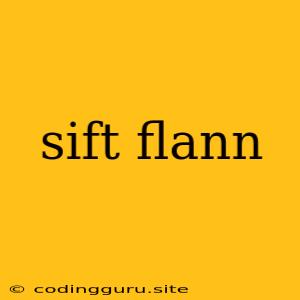SIFT and FLANN: A Powerful Duo for Feature Matching
In the realm of computer vision, object recognition and image retrieval, finding corresponding points between two images is a fundamental task. This is where SIFT (Scale-Invariant Feature Transform) and FLANN (Fast Library for Approximate Nearest Neighbors) come into play. Together, they form a robust and efficient solution for feature matching, paving the way for a wide range of applications.
What is SIFT?
SIFT is a keypoint detection and description algorithm, known for its robustness to scale, rotation, and illumination changes. It extracts distinctive features from images, allowing for precise comparisons even under challenging conditions.
Here's how SIFT works:
-
Scale-Space Extrema Detection: SIFT first constructs a scale-space representation of the image, generating multiple blurred versions of the original image. By analyzing the difference between these blurred images at different scales, potential keypoints are identified as local extrema.
-
Keypoint Localization: The detected keypoints are then refined using a sub-pixel interpolation technique to achieve greater accuracy.
-
Orientation Assignment: SIFT assigns an orientation to each keypoint based on the local gradient directions in its neighborhood, making it invariant to image rotation.
-
Descriptor Generation: A unique descriptor is created for each keypoint, encoding its appearance in the surrounding region. This descriptor captures the local gradient information, making it invariant to illumination changes and geometric distortions.
What is FLANN?
FLANN is a library designed for efficient nearest neighbor search, which is crucial for finding matching features between images. It utilizes a variety of algorithms to speed up the search process, including:
- k-d trees: This technique partitions the feature space into a hierarchical structure, enabling fast searching for similar features.
- k-means clustering: This method groups similar features into clusters, reducing the search space and accelerating the process.
- Linear search: While simple, linear search can be effective for smaller datasets and situations where accuracy is paramount.
Why Combine SIFT and FLANN?
SIFT provides a robust and descriptive representation of keypoints, but the process of finding matching features between two images can be computationally expensive. This is where FLANN comes in. By efficiently searching for nearest neighbors among the descriptors generated by SIFT, FLANN significantly speeds up the matching process without sacrificing accuracy.
How to Use SIFT and FLANN Together
Here's a simplified example of how to use SIFT and FLANN in Python using the OpenCV library:
import cv2
import numpy as np
# Load the images
img1 = cv2.imread('image1.jpg')
img2 = cv2.imread('image2.jpg')
# Create SIFT object
sift = cv2.SIFT_create()
# Detect keypoints and compute descriptors
kp1, des1 = sift.detectAndCompute(img1, None)
kp2, des2 = sift.detectAndCompute(img2, None)
# Create FLANN matcher object
flann = cv2.FlannBasedMatcher(dict(algorithm=1, trees=5), dict(checks=50))
# Match descriptors
matches = flann.knnMatch(des1, des2, k=2)
# Filter matches based on ratio test
good_matches = []
for m, n in matches:
if m.distance < 0.7 * n.distance:
good_matches.append(m)
# Draw matches
img_matches = cv2.drawMatches(img1, kp1, img2, kp2, good_matches, None, flags=2)
cv2.imshow('Matches', img_matches)
cv2.waitKey(0)
This code snippet demonstrates the basic steps involved in using SIFT and FLANN for feature matching:
- Create SIFT object: The cv2.SIFT_create() function instantiates a SIFT object.
- Detect and compute descriptors: The detectAndCompute() method extracts keypoints and their descriptors from the input images.
- Create FLANN matcher object: The cv2.FlannBasedMatcher() function creates a FLANN matcher with specified parameters.
- Match descriptors: The knnMatch() method uses FLANN to find nearest neighbors between the descriptors from the two images.
- Filter matches: The ratio test is applied to filter out potentially incorrect matches, ensuring a high-quality set of matching keypoints.
- Draw matches: The matching keypoints are visualized by drawing lines between corresponding points on the two images.
Applications of SIFT and FLANN
SIFT and FLANN have a wide range of applications in computer vision and image processing, including:
- Object recognition: Identifying objects in images and videos based on their distinctive features.
- Image retrieval: Finding images similar to a given query image based on shared features.
- 3D reconstruction: Creating 3D models of objects from multiple images.
- Image stitching: Combining multiple images to create a panoramic view.
- Motion tracking: Tracking the movement of objects in video sequences.
Advantages of Using SIFT and FLANN
- Robustness: SIFT is highly resilient to changes in scale, rotation, and illumination, ensuring reliable feature detection across different images.
- Efficiency: FLANN accelerates the matching process, making it suitable for real-time applications.
- Accuracy: The combination of SIFT and FLANN delivers high-quality matching results, minimizing the number of false positives.
Limitations of SIFT and FLANN
- Computational complexity: While FLANN significantly improves efficiency, the process of feature extraction and matching can still be computationally demanding, especially for large images.
- Sensitivity to noise: SIFT can be susceptible to noise in the image, potentially affecting feature detection and matching accuracy.
- Lack of contextual information: SIFT and FLANN focus on local features, potentially neglecting global context in some applications.
Conclusion
SIFT and FLANN are powerful tools for feature matching, providing a robust and efficient solution for a wide range of computer vision tasks. Their combined strengths make them suitable for applications that require reliable feature detection, accurate matching, and fast processing speeds. While limitations exist, the advantages of using SIFT and FLANN significantly outweigh them, making them indispensable components of modern computer vision systems.
